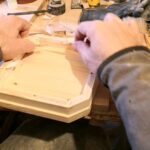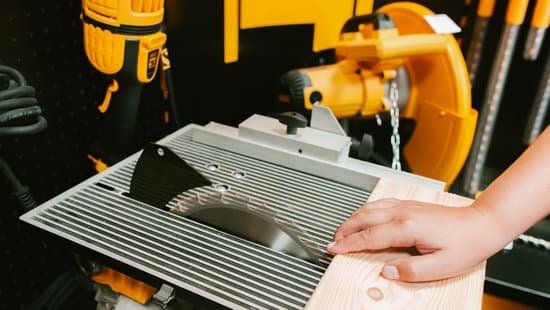Are you an aspiring handyman looking to take on a new project? In this article, we will guide you through the process of building your very own simple woodworking table. We’ll explore the benefits of constructing your own table, the materials and tools you’ll need, tips for choosing the right wood, step-by-step instructions for building the frame and creating a sturdy surface, as well as adding finishing touches and protective coatings.
Building your own woodworking table not only saves you money, but it also allows you to customize the design to suit your specific needs and preferences. By constructing the table yourself, you have full control over its size, shape, and features. Additionally, this hands-on project can be a rewarding experience that provides a sense of accomplishment and pride in creating something from scratch.
In the following sections, we will outline everything you need to know about building a simple woodworking table. From selecting the right materials and tools to troubleshooting common issues during construction and providing maintenance tips for your finished piece, this comprehensive guide will equip you with all the knowledge necessary to tackle this DIY project with confidence. Let’s get started on creating your very own custom woodworking table.
Materials and Tools Needed for Building a Simple Woodworking Table
If you are considering building a simple woodworking table, it is essential to have the right materials and tools on hand before starting your project. The materials you will need include wood for the tabletop and frame, screws, wood glue, sandpaper, and a finish or protective coating.
For the tabletop, it is important to select a sturdy and durable type of wood such as oak, maple, or pine. These types of wood are known for their strength and ability to withstand wear and tear.
In addition to the materials, there are several tools that will be necessary for building your woodworking table. These tools include a saw for cutting the wood to size, a drill for making pilot holes and attaching the pieces together, clamps for holding pieces in place during assembly, a sander for smoothing out rough edges, and a tape measure and level for ensuring accuracy in your construction.
Having these tools readily available will make the building process much smoother and efficient.
When gathering materials and tools for your woodworking project, it is important to consider the quality of each item. Investing in high-quality wood and durable tools will ultimately result in a more reliable and long-lasting woodworking table. By using top-notch materials and tools, you can ensure that your finished product will not only look great but also stand the test of time.
Choosing the Right Wood for Your Project
When it comes to building a simple woodworking table, one of the most important decisions you’ll need to make is choosing the right type of wood for your project. The type of wood you select will not only impact the overall look of your table, but also its durability and strength. Here are some considerations to keep in mind when choosing the right wood for your woodworking table:
- Hardwood vs. softwood: Determine whether you want to use hardwood or softwood for your table. Hardwoods like oak, cherry, or maple are known for their durability and resistance to wear and tear, making them ideal for tabletops. Softwoods like pine or cedar, on the other hand, may be more affordable and easier to work with.
- Grain pattern: Consider the grain pattern and texture of the wood you choose. If you’re going for a rustic or natural look, you may opt for wood with a prominent grain pattern. If you prefer a smoother, more uniform appearance, selecting wood with a finer grain might be more suitable.
- Moisture resistance: Think about where your woodworking table will be located and how it will be used. If it’s going to be placed in a damp or humid environment, you’ll want to choose a wood species that is resistant to moisture and less prone to warping or rotting.
Ultimately, the type of wood you choose should align with your personal preferences as well as the specific needs and requirements of your woodworking project. Taking the time to carefully consider these factors will help ensure that you end up with a beautiful and functional woodworking table that meets your expectations.
Before making any final decisions about which type of wood to use for your project, it’s important to conduct thorough research and possibly consult with knowledgeable professionals at your local lumberyard or home improvement store. They can provide valuable insights and recommendations based on their expertise and experience working with different types of wood materials.
Step-by-Step Instructions for Constructing the Table’s Frame
Building the frame for your woodworking table is a crucial part of the construction process. Here is a step-by-step guide to help you create a sturdy and reliable frame for your table:
1. Measure and cut the wood: Begin by measuring and cutting the lumber according to the dimensions of your table. Make sure to use a sawhorse or workbench to securely hold the wood in place while cutting.
2. Assemble the legs: Using screws or dowels, assemble the legs of the table. Ensure that they are straight and level before attaching them to the tabletop frame.
3. Connect the aprons: The aprons are horizontal pieces that connect the legs of the table. Use clamps to hold them in place before screwing or gluing them together.
4. Add support braces: To provide additional stability, add support braces between each leg of the table. This will prevent wobbling and ensure that your woodworking table can withstand heavy use.
5. Check for levelness: Use a level to check if your frame is even and stable on all sides before proceeding with building the table surface.
Remember that taking accurate measurements and using precise cutting techniques are essential for constructing a strong and durable frame for your woodworking table.
By following these step-by-step instructions, you can successfully build a simple woodworking table from scratch without any issues.
Tips for Creating a Sturdy and Reliable Table Surface
Building a reliable and sturdy table surface is crucial for any woodworking table. Whether you are using your table for sawing, sanding, or assembly, having a flat and stable surface is essential. Here are some tips to ensure that your woodworking table has a strong and durable surface that will last for years to come.
Choosing the Right Wood
The type of wood you choose for your tabletop will greatly impact its strength and reliability. Hardwoods such as oak, maple, or cherry are excellent choices for tabletops as they are dense and less prone to warping or denting. Avoid softer woods like pine or cedar, which may not hold up as well under the pressures of woodworking tasks.
Proper Assembly
When constructing the tabletop, be sure to use strong joinery techniques such as mortise and tenon or dovetail joints to ensure that the tabletop remains stable over time. Additionally, using a sturdy base frame and reinforcing it with cross supports will add extra stability to the overall structure of the table.
Applying a Durable Finish
To protect the surface of your woodworking table from scratches, moisture, and wear, applying a durable finish is essential. Consider using polyurethane or epoxy coatings for added protection. These finishes not only provide a smooth and level surface but also enhance the overall durability of your table.
By following these tips for creating a sturdy and reliable table surface how to build a simple woodworking table you can ensure that your finished woodworking table will be able to withstand heavy use without compromising its integrity. Taking the time to choose the right wood, use proper assembly techniques, and apply a durable finish will result in a high-quality woodworking table that you can rely on for all your future projects.
Adding Finishing Touches and Protective Coatings to Your Woodworking Table
Once you have constructed the frame and surface of your woodworking table, the next step is to add finishing touches and protective coatings to ensure its longevity and enhance its appearance. Properly finishing your woodworking table will not only protect it from wear and tear but also bring out the natural beauty of the wood.
Before applying any finish, it is important to thoroughly sand the entire table to create a smooth surface for the finish to adhere to. Use a fine-grit sandpaper and work in the direction of the wood grain to avoid scratches. Once sanded, remove any dust or debris using a tack cloth or vacuum cleaner.
After sanding, you can choose from a variety of finishes such as stain, paint, or clear sealant. Stain can enhance the natural color of the wood while sealant provides protection against moisture and spills. If you prefer a painted finish, be sure to apply primer first before painting to ensure an even coat. Once your desired finish is applied, allow it to dry completely before adding any protective coatings.
To protect your woodworking table from scratches and damages, consider adding a clear protective coating such as polyurethane or lacquer. These coatings provide an extra layer of protection while also adding a glossy or matte finish depending on your preference.
| Finishing Options | Benefits |
|---|---|
| Stain | Enhances natural wood color |
| Sealant | Protects against moisture and spills |
| Polyurethane or Lacquer | Adds extra protection and glossy/matte finish |
Troubleshooting Common Issues and Mistakes During the Construction Process
Preventing Warping and Shifting
One common issue that can arise during the construction of a woodworking table is the warping or shifting of the wood. To prevent this, it’s essential to choose high-quality, kiln-dried lumber for your project.
Additionally, be sure to properly seal and finish the wood to protect it from moisture, which can lead to warping over time. Using proper joinery techniques and ensuring that the table frame is square and level will also help prevent any shifting of the wood over time.
Dealing With Uneven Surfaces
Another potential issue that may occur during construction is creating an uneven surface for your woodworking table. This can result from not properly leveling the table frame or using warped or irregular pieces of wood for the tabletop.
To remedy this issue, it’s important to meticulously measure and check for level throughout the construction process. If an uneven surface does occur, sanding down high spots or adding shims under the table legs can help create a level surface for your woodworking projects.
Addressing Weak Joints and Connections
Weak joints and connections can pose a significant problem for the stability and longevity of your woodworking table. One mistake that can lead to this issue is not using the appropriate fasteners or adhesive when assembling the table frame.
To avoid weak joints, be sure to use quality screws, bolts, or dowels, along with wood glue if needed, to secure all connections. It’s also important to double-check all joints and connections throughout the construction process to ensure they are sturdy and reliable.
By being aware of these potential issues and knowing how to address them, you can ensure that your woodworking table construction process goes smoothly and results in a sturdy and reliable finished product.
Maintenance and Care for Your Finished Woodworking Table
Having successfully completed the construction of your simple woodworking table, it is essential to understand the importance of maintenance and care to ensure its longevity and optimal functionality. Taking proper care of your finished woodworking table will not only preserve its appearance but also contribute to its overall durability.
First and foremost, regular cleaning is crucial for maintaining the quality of your woodworking table. Use a damp cloth to remove any dust, dirt, or wood shavings from the surface and legs. Avoid using harsh chemical cleaners as they can damage the wood and its finish. Instead, opt for a mild soap solution when necessary.
In addition to cleaning, it is important to protect your woodworking table from excessive moisture and extreme temperature changes. Direct exposure to sunlight or placing hot items directly on the surface can lead to warping or discoloration over time. Consider using coasters, placemats, or trivets to prevent moisture and heat damage. Furthermore, maintaining a stable indoor environment with consistent humidity levels can help preserve the structure of the wood. A dehumidifier or humidifier may be necessary in fluctuating climates.
Lastly, periodic inspections of your woodworking table are essential for identifying any potential issues that may arise over time. Check for loose joints, cracks, or wear on the surface finish. Addressing these issues promptly will help prevent them from escalating into larger problems that require extensive repairs.
By following these maintenance and care guidelines, you can ensure that your finished woodworking table remains in excellent condition for years to come. Taking proactive steps to preserve the quality of your craftsmanship will allow you to enjoy the satisfaction of building and using a reliable piece of furniture that you created yourself.
Conclusion
In conclusion, building a simple woodworking table is a rewarding and fulfilling project that allows you to create a functional piece of furniture from scratch. The process of constructing the table provides a sense of accomplishment and pride as you see your hard work come to life. By following step-by-step instructions and utilizing the right materials and tools, you can build a high-quality woodworking table that meets your specific needs.
One of the most satisfying aspects of building your own woodworking table is the ability to customize it to your preferences. From choosing the type of wood to adding finishing touches, you have full control over the design and construction process. This level of personalization ensures that the finished table perfectly complements your space while reflecting your unique style.
Moreover, completing a woodworking project such as building a table offers valuable learning experiences and skills development. Throughout the construction process, you can enhance your knowledge of woodworking techniques, problem-solving abilities, and attention to detail. Not only will you have a functional piece of furniture at the end, but you will also have gained new expertise in woodworking and craftsmanship.
Overall, building a simple woodworking table is an immensely gratifying endeavor that allows you to showcase your creativity and handiwork in a practical way. Whether you are an experienced woodworker or just starting out, constructing your own table is an enriching experience with long-lasting rewards both aesthetically and personally.
Frequently Asked Questions
Is It Cheaper to Build a Workbench?
Building a workbench can be cheaper than purchasing one, especially if you already have access to some basic tools and materials. By using affordable lumber and simple construction techniques, you can customize the size and design to fit your specific needs without breaking the bank.
How Do You Make a Small Work Table?
Making a small work table is relatively easy and can be done with basic carpentry skills and tools. You can use plywood or solid wood for the tabletop, sturdy legs, and bracing to ensure stability. Adding a shelf underneath for storage or extra support can also be beneficial for a small work table.
What Is the Best Size for a Woodworking Table?
The best size for a woodworking table depends on the space available in your workshop and the type of projects you typically work on. However, a standard size for a woodworking table is around 3-4 feet wide by 6-8 feet long, providing enough surface area for most woodworking tasks while still being manageable in terms of space.

Hi everyone! I’m a woodworker and blogger, and this is my woodworking blog. In my blog, I share tips and tricks for woodworkers of all skill levels, as well as project ideas that you can try yourself.





